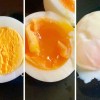
Despite media coverage, Japanese TV tends to lean towards the tame. You’ve got your History Channel-type stuff, your basic daytime dramas, your variety shows that are invariably focused on people eating food and the reactions of people watching said people eat food (spoiler: it’s delicious). You’ve got your movie re-runs and your weather forecasts.
But then, sometimes, you’ve got stuff like this: a man willingly, inexplicably letting a machine paddle him in the family jewels over and over again for what appears to be no reason at all.
For reasons that are difficult, perhaps impossible, to explain or fathom, the Japanese television show Ame Talk, recently featured a segment in which a man used what appears to be a bizarre exercise machine that swings foot-level paddles that alternate with a head-level paddle, thus forcing the user to jump and duck in rapid succession. Mistime a jump or screw up the rhythm and the machine will deliver a stinging but ultimately painless blow to your shins or face.
Unless, of course, you’re this guy. Because Three Stooges-style slapstick is still considered comedy gold in Japan, this poor sucker—who appears to be a small-time comedian—willfully subjects his nards to the mechanical punishment of this exercise machine, as he is seemingly knocked over by the whirring monstrosity and forced to submit to a brutal nut-slapping while the studio audience and the show’s hosts laugh hysterically at his misfortune.
On even mildly scrupulous viewing, it’s obvious the guy has just decided to lie down and take a ball-whacking on purpose, though, leading many foreign viewers (especially those in Taiwan, where the video has gone viral) to openly wonder why this type of stuff seems to find its way onto Japanese television so often. Attempting to understand the cultural and psychological reasons for this phenomenon is tempting madness, however, so let’s just go ahead and bask in the beautiful insanity of a man lying perfectly still while a machine paddles his balls for the amusement of millions.
Source: Yurukuyaru
Featured image: Wikimedia Commons

 Disillusionment at Tsukiji’s tourist-target prices led us to a great ramen restaurant in Tokyo
Disillusionment at Tsukiji’s tourist-target prices led us to a great ramen restaurant in Tokyo Lacquerware supplier to emperor of Japan and Pokémon team up for new tableware
Lacquerware supplier to emperor of Japan and Pokémon team up for new tableware Drunk cycling can result in an instantly suspended driver’s license in Japan
Drunk cycling can result in an instantly suspended driver’s license in Japan We tried a Japanese egg steamer to achieve the perfect breakfast eggs without a stove
We tried a Japanese egg steamer to achieve the perfect breakfast eggs without a stove A trip to hell on Japan’s ‘vomit ship’: Is it as bad as everyone says it is?
A trip to hell on Japan’s ‘vomit ship’: Is it as bad as everyone says it is? Disillusionment at Tsukiji’s tourist-target prices led us to a great ramen restaurant in Tokyo
Disillusionment at Tsukiji’s tourist-target prices led us to a great ramen restaurant in Tokyo Lacquerware supplier to emperor of Japan and Pokémon team up for new tableware
Lacquerware supplier to emperor of Japan and Pokémon team up for new tableware Drunk cycling can result in an instantly suspended driver’s license in Japan
Drunk cycling can result in an instantly suspended driver’s license in Japan We tried a Japanese egg steamer to achieve the perfect breakfast eggs without a stove
We tried a Japanese egg steamer to achieve the perfect breakfast eggs without a stove A trip to hell on Japan’s ‘vomit ship’: Is it as bad as everyone says it is?
A trip to hell on Japan’s ‘vomit ship’: Is it as bad as everyone says it is? Rice cooker kuri gohan and two more super-easy chestnut recipes to make this fall【SoraKitchen】
Rice cooker kuri gohan and two more super-easy chestnut recipes to make this fall【SoraKitchen】 Soup curry and onigiri for breakfast at a super tasty semi-secret spot in Tokyo’s Shinjuku
Soup curry and onigiri for breakfast at a super tasty semi-secret spot in Tokyo’s Shinjuku 10 great autumn Japan travel spots for fall colors and retro atmosphere【Survey】
10 great autumn Japan travel spots for fall colors and retro atmosphere【Survey】 Is the all-you-can-eat KFC buffet in Tokyo really as good as they say it is?
Is the all-you-can-eat KFC buffet in Tokyo really as good as they say it is? Kina Shen: The beautiful Asian woman who looks like a living doll【Video, pics】
Kina Shen: The beautiful Asian woman who looks like a living doll【Video, pics】 7-Eleven Japan starts new temporary luggage storage service in over 300 branches
7-Eleven Japan starts new temporary luggage storage service in over 300 branches Starbucks teams up with 166-year-old Kyoto doll maker for Year of the Horse decorations【Photos】
Starbucks teams up with 166-year-old Kyoto doll maker for Year of the Horse decorations【Photos】 Tokyo’s Tsukiji sushi neighborhood asks tour groups to stay away for the rest of the month
Tokyo’s Tsukiji sushi neighborhood asks tour groups to stay away for the rest of the month Street Fighter Hadouken Churros to be launched and eaten in Tokyo, Okami pudding on offer too
Street Fighter Hadouken Churros to be launched and eaten in Tokyo, Okami pudding on offer too Japanese woman mistaken for bear
Japanese woman mistaken for bear Return of Totoro sequel short anime announced for Ghibli Park
Return of Totoro sequel short anime announced for Ghibli Park Starbucks Japan releases new zodiac chilled cup drink for 2026
Starbucks Japan releases new zodiac chilled cup drink for 2026 Is this the most relaxing Starbucks in Japan?
Is this the most relaxing Starbucks in Japan? Starbucks on a Shinkansen bullet train platform: 6 tips for using the automated store in Japan
Starbucks on a Shinkansen bullet train platform: 6 tips for using the automated store in Japan Japan’s human washing machines will go on sale to general public, demos to be held in Tokyo
Japan’s human washing machines will go on sale to general public, demos to be held in Tokyo Japanese train company is letting fans buy its actual ticket gates for their homes
Japanese train company is letting fans buy its actual ticket gates for their homes Is China’s don’t-go-to-Japan warning affecting tourist crowds in Tokyo’s Asakusa neighborhood?
Is China’s don’t-go-to-Japan warning affecting tourist crowds in Tokyo’s Asakusa neighborhood? Starbucks Japan unveils new Christmas goods and a rhinestone tumbler that costs 19,500 yen
Starbucks Japan unveils new Christmas goods and a rhinestone tumbler that costs 19,500 yen Tokyo considering law requiring more trash cans following litter increase in heavily touristed area
Tokyo considering law requiring more trash cans following litter increase in heavily touristed area Nintendo’s Kirby now delivering orders at Kura Sushi restaurants, but not in Japan
Nintendo’s Kirby now delivering orders at Kura Sushi restaurants, but not in Japan Tokyo event lets you travel back in time, for free, to celebrate 100 years since Showa era start
Tokyo event lets you travel back in time, for free, to celebrate 100 years since Showa era start Survey asks foreign tourists what bothered them in Japan, more than half gave same answer
Survey asks foreign tourists what bothered them in Japan, more than half gave same answer Japan’s deadliest food claims more victims, but why do people keep eating it for New Year’s?
Japan’s deadliest food claims more victims, but why do people keep eating it for New Year’s? We deeply regret going into this tunnel on our walk in the mountains of Japan
We deeply regret going into this tunnel on our walk in the mountains of Japan Studio Ghibli releases Kodama forest spirits from Princess Mononoke to light up your home
Studio Ghibli releases Kodama forest spirits from Princess Mononoke to light up your home Major Japanese hotel chain says reservations via overseas booking sites may not be valid
Major Japanese hotel chain says reservations via overseas booking sites may not be valid Put sesame oil in your coffee? Japanese maker says it’s the best way to start your day【Taste test】
Put sesame oil in your coffee? Japanese maker says it’s the best way to start your day【Taste test】 The top 10 annoying foreign tourist behaviors on trains, as chosen by Japanese people【Survey】
The top 10 annoying foreign tourist behaviors on trains, as chosen by Japanese people【Survey】 No more using real katana for tourism activities, Japan’s National Police Agency says
No more using real katana for tourism activities, Japan’s National Police Agency says Starbucks Japan reveals new sakura drinkware collection, inspired by evening cherry blossoms
Starbucks Japan reveals new sakura drinkware collection, inspired by evening cherry blossoms Rice cooker kuri gohan and two more super-easy chestnut recipes to make this fall【SoraKitchen】
Rice cooker kuri gohan and two more super-easy chestnut recipes to make this fall【SoraKitchen】 Soup curry and onigiri for breakfast at a super tasty semi-secret spot in Tokyo’s Shinjuku
Soup curry and onigiri for breakfast at a super tasty semi-secret spot in Tokyo’s Shinjuku 10 great autumn Japan travel spots for fall colors and retro atmosphere【Survey】
10 great autumn Japan travel spots for fall colors and retro atmosphere【Survey】 Is the all-you-can-eat KFC buffet in Tokyo really as good as they say it is?
Is the all-you-can-eat KFC buffet in Tokyo really as good as they say it is? Kina Shen: The beautiful Asian woman who looks like a living doll【Video, pics】
Kina Shen: The beautiful Asian woman who looks like a living doll【Video, pics】 Light-up Master Sword, Rupee dishes, and heart notebook all part of new Legend of Zelda merch line
Light-up Master Sword, Rupee dishes, and heart notebook all part of new Legend of Zelda merch line More people in Japan quit sending New Year’s cards and many have started to regret it
More people in Japan quit sending New Year’s cards and many have started to regret it Totoro Full of Poses figures are full of joyful cuteness, complete set comes with a surprise
Totoro Full of Poses figures are full of joyful cuteness, complete set comes with a surprise Starbucks vs. Tully’s — Is there such a big difference between Japan’s coffee giants?【Taste test】
Starbucks vs. Tully’s — Is there such a big difference between Japan’s coffee giants?【Taste test】 Tokyo’s Tsukiji sushi neighborhood asks tour groups to stay away for the rest of the month
Tokyo’s Tsukiji sushi neighborhood asks tour groups to stay away for the rest of the month More Than a Capsule Stay: Why Solo Travelers Choose “global cabin Yokohama Chinatown”
More Than a Capsule Stay: Why Solo Travelers Choose “global cabin Yokohama Chinatown” Undress an ukiyo-e woman out of her kimono with this Japanese magic towel hack
Undress an ukiyo-e woman out of her kimono with this Japanese magic towel hack Upcoming Australian-made card game battle anime is a confusing mix of genres
Upcoming Australian-made card game battle anime is a confusing mix of genres
Leave a Reply